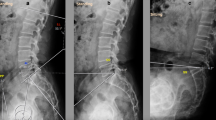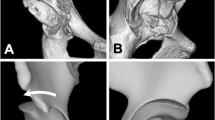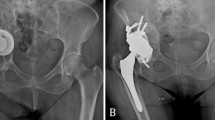Abstract
Purpose
The potential influence of acetabular component orientation on iliopsoas impingement in total hip arthroplasty (THA) has not been previously quantified. The aim of the present study was to utilize pre- and post-operative CT-based 3D models to quantify iliopsoas impingement on acetabular components, and to identify any potential factors associated with iliopsoas impingement.
Methods
Iliopsoas muscle was modelled from pre-operative CT scans and transferred to the post-operative 3D models in 19 THAs. The volume and the area of the overlap between iliopsoas muscle and acetabular cup (iliopsoas volume & area) was measured on axial and sagittal images. Most protruded lengths of cup uncovered by acetabular bone were measured on axial sagittal scan of CT scans. Version of acetabulum, acetabular cup, and the difference between the two (version difference) were also measured with cup inclination and size. Linear regression analysis was performed to identify any factor influencing iliopsoas impingement.
Results
Iliopsoas impingement volume and area were 100.6 ± 226.1 (range, 0.0–663.9) mm³ and 52.6 ± 102.0 (0.0–342.3) mm³, respectively. The protruded lengths on axial and sagittal view were 6.9 ± 5.3 (0.0–16.0) and 2.1 ± 2.7 (0.0–8.0). Linear regression model showed that version difference was significantly related to the iliopsoas impingement volume and area (beta = −0.709, p = 0.041 for volume, and beta = −0.684, p = 0.047 for area).
Conclusions
The results of this study demonstrate that iliopsoas impingement on acetabular components was influenced by the version difference between pre-operative acetabular bone and acetabular component rather than the magnitude of post-operative cup version alone.


Similar content being viewed by others
References
Duffy PJ, Masri BA, Garbuz DS, Duncan CP (2005) Evaluation of patients with pain following total hip replacement. J Bone Joint Surg Am 87(11):2566–2575
Reichert JC, Volkmann MR, Koppmair M, Rackwitz L, Ludemann M, Rudert M, Noth U (2015) Comparative retrospective study of the direct anterior and transgluteal approaches for primary total hip arthroplasty. Int Orthop 39(12):2309–2313. doi:10.1007/s00264-015-2732-8
Britton AR, Murray DW, Bulstrode CJ, McPherson K, Denham RA (1997) Pain levels after total hip replacement: their use as endpoints for survival analysis. J Bone Joint Surg (Br) 79(1):93–98
Ala Eddine T, Remy F, Chantelot C, Giraud F, Migaud H, Duquennoy A (2001) Anterior iliopsoas impingement after total hip arthroplasty: diagnosis and conservative treatment in 9 cases. Rev Chir Orthop Reparatrice Appar Mot 87(8):815–819
Lachiewicz PF, Kauk JR (2009) Anterior iliopsoas impingement and tendinitis after total hip arthroplasty. J Am Acad Orthop Surg 17(6):337–344
Adler RS, Buly R, Ambrose R, Sculco T (2005) Diagnostic and therapeutic use of sonography-guided iliopsoas peritendinous injections. AJR Am J Roentgenol 185(4):940–943. doi:10.2214/AJR.04.1207
Bianchi S, Martinoli C, Keller A, Bianchi-Zamorani MP (2002) Giant iliopsoas bursitis: sonographic findings with magnetic resonance correlations. J Clin Ultrasound 30(7):437–441. doi:10.1002/jcu.10093
Rezig R, Copercini M, Montet X, Martinoli C, Bianchi S (2004) Ultrasound diagnosis of anterior iliopsoas impingement in total hip replacement. Skeletal Radiol 33(2):112–116. doi:10.1007/s00256-003-0703-4
Wank R, Miller TT, Shapiro JF (2004) Sonographically guided injection of anesthetic for iliopsoas tendinopathy after total hip arthroplasty. J Clin Ultrasound 32(7):354–357. doi:10.1002/jcu.20043
Cyteval C, Sarrabere MP, Cottin A, Assi C, Morcos L, Maury P, Taourel P (2003) Iliopsoas impingement on the acetabular component: radiologic and computed tomography findings of a rare hip prosthesis complication in eight cases. J Comput Assist Tomogr 27(2):183–188
Dora C, Houweling M, Koch P, Sierra RJ (2007) Iliopsoas impingement after total hip replacement: the results of non-operative management, tenotomy or acetabular revision. J Bone Joint Surg (Br) 89(8):1031–1035. doi:10.1302/0301-620X.89B8.19208
Kim JS, Park TS, Park SB, Kim IY, Kim SI (2000) Measurement of femoral neck anteversion in 3D. Part 2: 3D modelling method. Med Biol Eng Comput 38(6):610–616
Sugano N, Noble PC, Kamaric E (1998) A comparison of alternative methods of measuring femoral anteversion. J Comput Assist Tomogr 22(4):610–614
Tsai TY, Li JS, Wang S, Lin H, Malchau H, Li G, Rubash H, Kwon YM (2013) A novel dual fluoroscopic imaging method for determination of THA kinematics: in-vitro and in-vivo study. J Biomech 46(7):1300–1304. doi:10.1016/j.jbiomech.2013.02.010
Murray DW (1993) The definition and measurement of acetabular orientation. J Bone Joint Surg (Br) 75(2):228–232
Potter HG, Nestor BJ, Sofka CM, Ho ST, Peters LE, Salvati EA (2004) Magnetic resonance imaging after total hip arthroplasty: evaluation of periprosthetic soft tissue. J Bone Joint Surg Am 86-A(9):1947–1954
Bricteux S, Beguin L, Fessy MH (2001) Iliopsoas impingement in 12 patients with a total hip arthroplasty. Rev Chir Orthop Reparatrice Appar Mot 87(8):820–825
Lequesne M, Dang N, Montagne P, Lemoine A, Witvoet J (1991) Conflict between psoas and total hip prosthesis. Rev Rhum Mal Osteoartic 58(9):559–564
Trousdale RT, Cabanela ME, Berry DJ (1995) Anterior iliopsoas impingement after total hip arthroplasty. J Arthroplasty 10(4):546–549
Dorr LD, Malik A, Dastane M, Wan Z (2009) Combined anteversion technique for total hip arthroplasty. Clin Orthop Relat Res 467(1):119–127. doi:10.1007/s11999-008-0598-4
Acknowledgments
The authors would like to acknowledge the technical guidance of Dr. Guoan Li. There was a partial funding from Mako Surgical Inc.
Author information
Authors and Affiliations
Corresponding author
Ethics declarations
Conflict of interest
The authors declare no competing interests.
Ethical review committee statement
This study was approved by the Institutional Review Board at the authors’ institute.
Rights and permissions
About this article
Cite this article
Park, K.K., Tsai, TY., Dimitriou, D. et al. Three-dimensional in vivo difference between native acetabular version and acetabular component version influences iliopsoas impingement after total hip arthroplasty. International Orthopaedics (SICOT) 40, 1807–1812 (2016). https://doi.org/10.1007/s00264-015-3055-5
Received:
Accepted:
Published:
Issue Date:
DOI: https://doi.org/10.1007/s00264-015-3055-5




